Nucleolus:
- Fontana (1781) discovered the presence of round oval bodies called Nucleoli (Nucleolus-singular) embedded in the nucleoplasm.
- It does not have a membrane.
- Nucleoli are associated with the nuclear organizing portion of the chromosomes.
- The size of the nucleoli is related to the activities of the cell. Cells that are actively involved in protein synthesis have a large nucleoli and vice-versa.
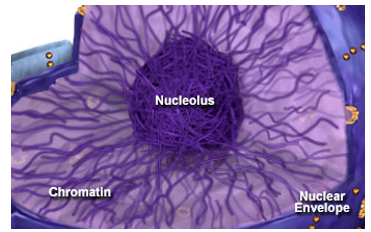
Chemically, nucleolus is made up of proteins and RNA. The important function of the nucleolus is the synthesis of ribosomal RNA and protein. Hence, it is a major site of active ribosome sysnthesis.
It is seen distinctly only in the interphase of a cell. During the division of the nucleus, the nucleolus disappears and a new nucleolus develops in each daughter nucleus.
Chromatin reticulum:
The nucleoplasm contains many thread-like, coiled and elongated structures made of nucleoprotein fibres. These thread – like structures are known as the chromatin substances or chromatin fibres or chromatin reticulum (chrome-colour).
- It is seen distinctly in the interphase nucleus.
- Chemically it is made up of DNA, some basic proteins called histones, non-histone proteins and RNA (and hence called nucleoprotein).
- During metaphase, the chromatin network is condensed to form thick ribbon- like bodies called chromosomes.
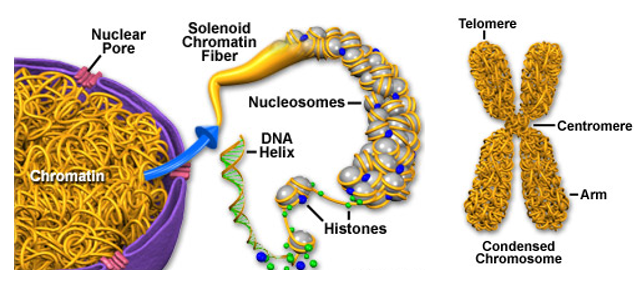
- At certain places, the chromatin network remains condensed as darkly which take readily the basic stains called heterochromatin and the less stained region is called euchromatin.
- Hetero-chromatin is usually an inactive region and euchromatin is the active region.
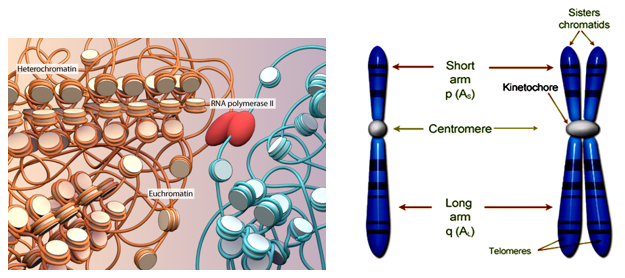
Chromosome
- Chromosomes are clearly visible (through light microscope) only in the metaphase stage of cell cycle.
- Each chromosome has two arms- a long arm (q) and a short arm (p).
- In metaphase each arm splits longitudinally into two halves called chromatids.
- Each chromosome has a constriction called primary constriction.
- The clear unstainable zone at the region of primary constriction is called kinetochore or centromere.
- Occasionally, chromosomes contain additional constriction other than the primary constriction, called secondary constriction.
- The small portion located beyond the secondary constriction is called satellite.
- Chromosomes with satellite are called SAT (Sine Acido Thymonucleinico) chromosomes.
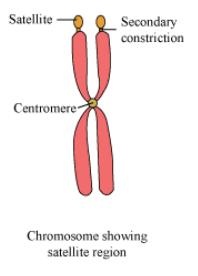
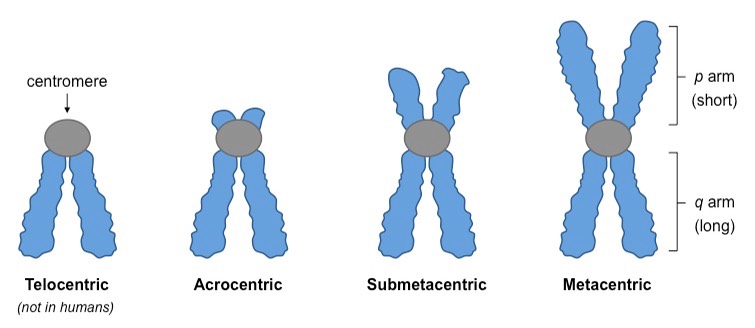
Based on the position of the centromere, chromosomes are of four types.
- Metacentric – The centromere is near the middle of the chromosome. The two arms are nearly equal.
- Submetacentric – The centromere is situated some distance away from the middle. One arm will be shorter than the outer.
- Acrocentric – The centromere is situated near the end of the chromosome.
- Telocentric – The centromere is situated at the tip of the chromosome
Functions.
- They control the heredity.
- They control the metabolism of an individual.
- Heterochromatin helps in the formation of nucleolus.
- Chromosomes control the differentiation of different characteristics of an organism.
- Changes in the number, position and structure of chromosomes lead to the formation of new species.
